Black and orange caterpillars come in a wide range of configurations, from slim spindles to luxurious tufts of fuzz. The color schemes for these critters also vary widely, with some adorned in various shades of black and orange, while others have intricate patterns that are almost artworks in their own right.
Whether thin and sleek or chubby and cuddly, each of these lovable caterpillars has special designs that are sure to fascinate anyone lucky enough to catch a glimpse.
However, despite their appeal, it’s important to remember that some black and orange caterpillars can be extremely poisonous.
The problem with this is many people don’t know which ones are poisonous or how to identify them! The good news is everything you need to know including the names, descriptions, and photos of each caterpillar that is poisonous is in this article.
8 Black And Orange Caterpillars That Are Poisonous
1. Cape Lappet Moth Caterpillar
Many people are familiar with brightly colored caterpillars, but few know about “Cape Lappet Moth caterpillars” (Eutricha Capensis). This species is relatively common throughout South Africa and feeds on a wide variety of African plants.
They have unique characteristics that make them a special member of the Lepidoptera family.
The Cape Lappet Moth Caterpillar is also one of the more dangerous creatures as it’s highly poisonous!
In unsuspecting victims, its sharp spines that cover its body can cause a painful reaction when touched due to the urticarial rashes they provoke.
This happens when these spines break off on contact and discharge a fluid that causes an intense stinging and burning sensation that can last for hours afterward.
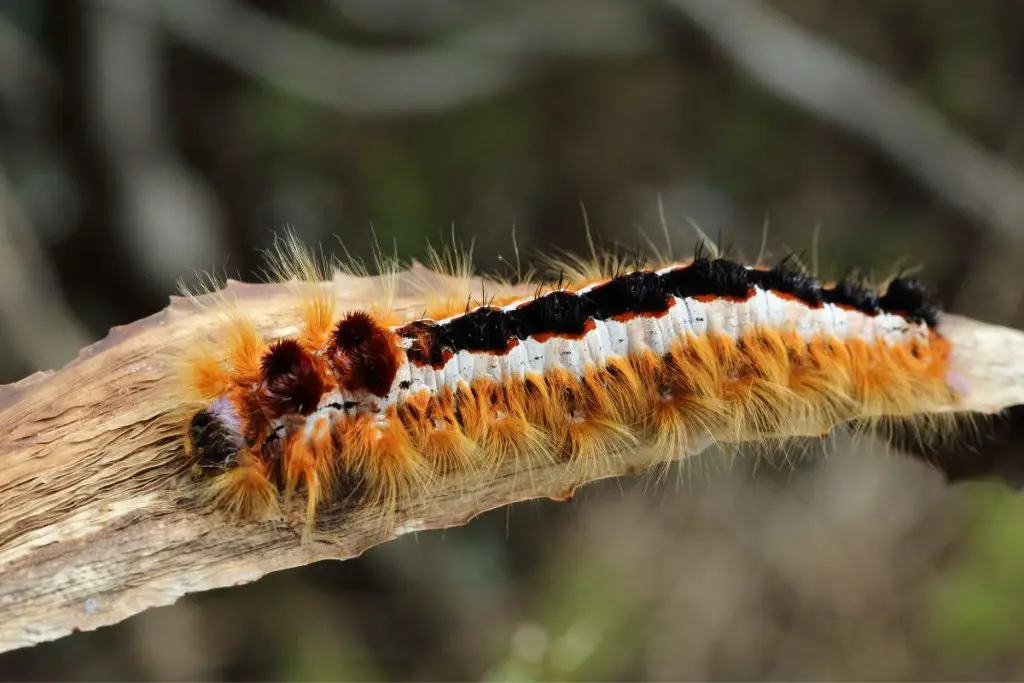
The Cape Lappet Moth Caterpillar is an instantly recognizable species due to its quite distinct look. It is covered in a luxuriant coat of long hairs, and arranged at the head are three large coppery tufts of hair as well as two smaller purple ones.
The edges along the side of its body have a row of oranges tufts for extra color, while a row of black triangles lines up down the middle of the caterpillars’ backs flanked by white patches on either side to complete the design.
Symptoms
- Red Blotches Accompanied By Skin Rash
- Stinging And Burning Sensation
Habitat
- Found Underneath Leaves Of African Plants
- Domestic Gardens, Remote Or Wild Areas
2. Cinnabar Moth Caterpillar
The cinnabar moth caterpillar is an extraordinary creature, easily identified by its smooth appearance and striking black, and yellow stripes.
This caterpillar is native to Europe and parts of Asia “but” has recently been introduced into New Zealand, Australia, and North America to help control ragwort (Senecio jacobaea) which is a type of toxic plant.
The cinnabar moth caterpillar exclusively feeds on ragwort, which makes them poisonous due to certain toxic compounds that are present in the plant itself.
In fact, once the caterpillar transitions into a moth, they possess high levels of histamine in its body, reaching as high as 700 μg which itself is believed to originate from ragwort.
Their color can also serve as a warning! As a result, they’re able to ward off predators with a sharp chemical defense!
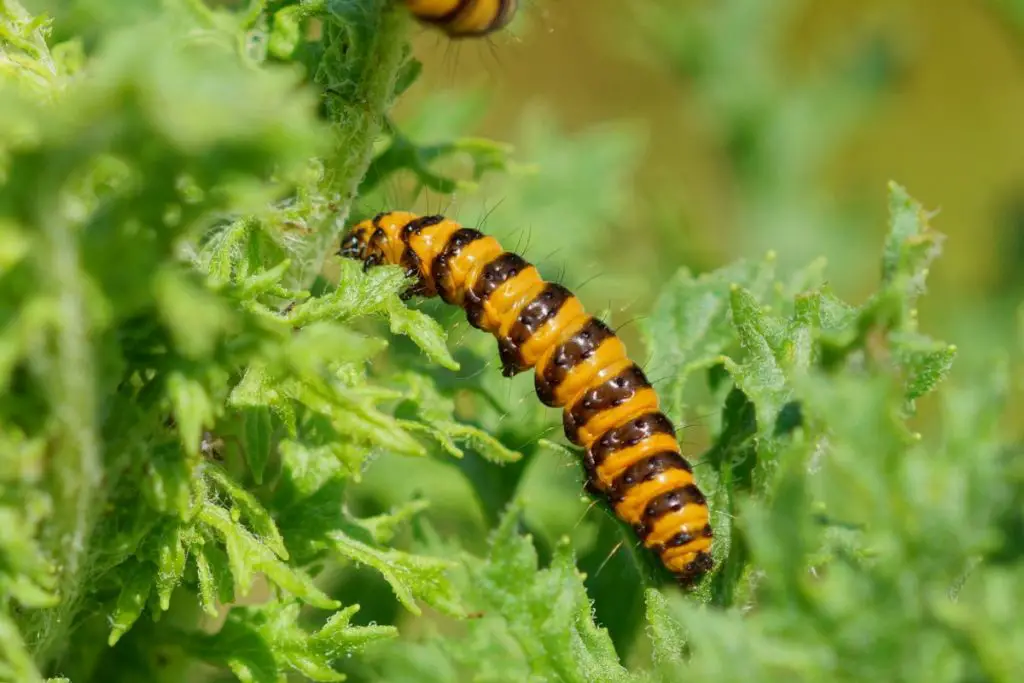
However, despite the toxicity carried in their bodies, Cinnabar Moth Caterpillars are quite harmless to humans. However, it’s highly advisable for us to still be wary of the allergic reactions that they can cause.
For example, if animals including pets consume this caterpillar it will most definitely be fatal. For humans, if touched, may cause a slight skin rash but that’s all nothing life-threatening.
Symptoms
- Slight Skin Rash If Touched
- Maybe Fatal If Consumed By Animals
Habitat
- Feeds On Ragwort Leaves
- Gardens, Meadows, Parks, Mature Sand Dunes
3. Yellow Tail Caterpillar
The yellow-tail caterpillar is an amazing species that has held the interest of many over the centuries. It was first described by Johann Kaspar Füssli in 1775 and is currently classified within the genus Euproctis.
These vivid creatures can be found throughout Europe and some may even travel as far eastward as the Urals and beyond, with some spotted in Siberia, India, and Sri Lanka.
This bright orange and black caterpillar is commonly referred to as the Yellow Tail caterpillar! However, this is not because of its color as a caterpillar!
But, rather the yellow-colored tufts that are located at the end of its tail when they turn into a moth, getting the name Yellow Tail moth caterpillar!
Unfortunately, its beauty can also be quite deceiving, as Yellow-tail caterpillars are incredibly poisonous when touched especially to children.
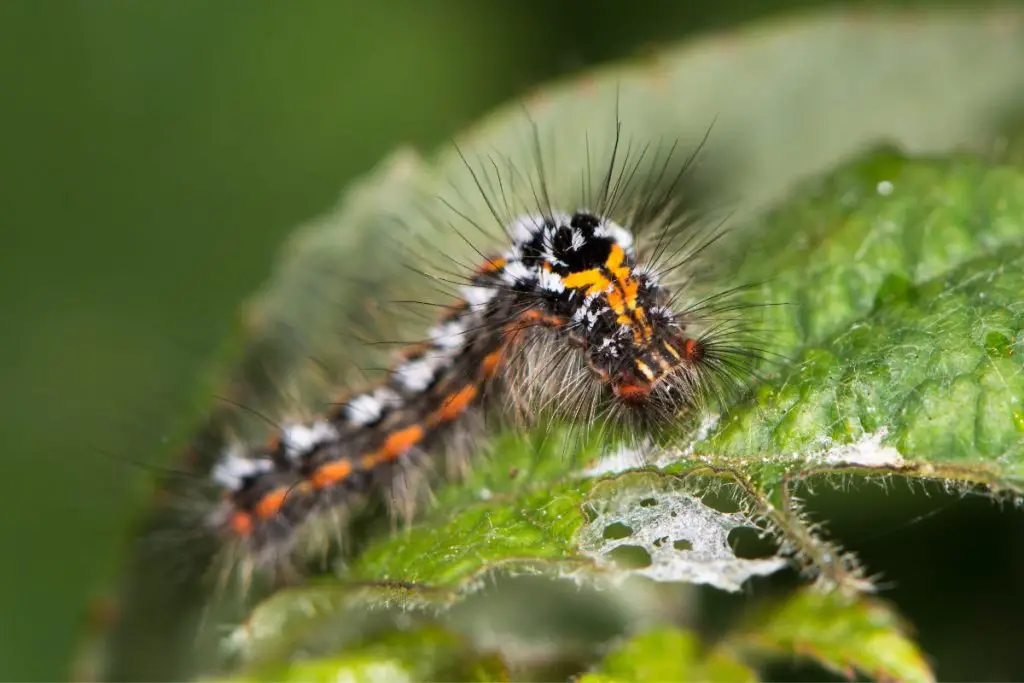
In fact, there was an article published on 25th 2020 at www.thesun.co.uk with reports of a little girl being rushed to hospital with a severe allergic reaction after being in contact with one of these caterpillars!
The tiny hairs that cover their bodies contain toxins that can cause severe rashes, headaches, breathing problems, and potential blindness if it comes into contact with the skin.
Symptoms
- Can Cause Severe Rashes
- Headaches, Breathing Problems
Habitat
- Found On Oak, Hawthorn, and Blackthorn Trees
- Gardens, Woodlands, Deciduous Tree Hedges
4. Garden Tiger Moth Caterpillar
The Garden Tiger Moth caterpillar is an incredibly weird-looking insect scientifically known as Arctia Caja, from the Erebidae family.
This caterpillar is typically found in the cold climates of the US, Canada, and Europe and has a unique relationship with its host plants, as it prefers to choose those that create pyrrolizidine alkaloids.
However, it’s their taste for “pyrrolizidine alkaloids” (PAs) that makes garden tiger moth caterpillars very poisonous.
(PAs) are basically naturally occurring toxins found in a number of different plants consumed by this caterpillar.
The alkaloids alternatively build up in the caterpillar’s body, making them toxic to predators that try to eat them.
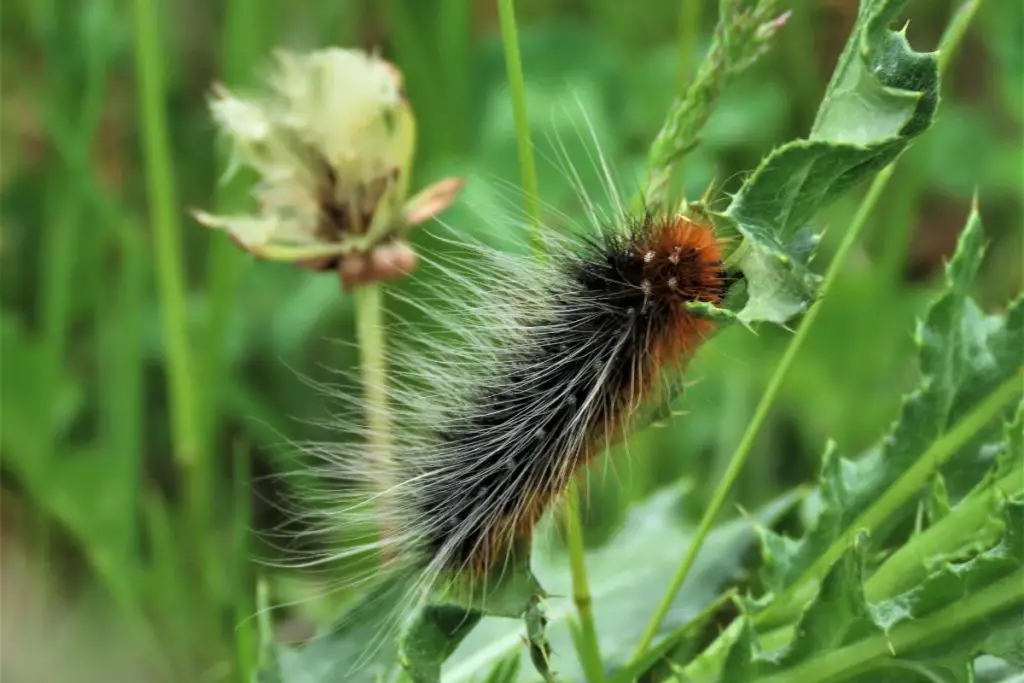
Of course, the garden tiger caterpillar also has unusually long hairs on their bodies that are known to cause hives, irritation, and even a “stinging” sensation for both humans and other mammals if touched.
So, it’s important for people to remember that these hairs are not just for show, and touching one can cause extreme itching and rashes lasting from several hours to a couple of days.
Symptoms
- Extreme Itching And Rashes
- Irritation, And Stinging Sensation
Habitat
- Stinging Nettles, Dock Leaves, And Garden Plants
- Found In Grasslands And Forests
5. Gulf Fritillary Caterpillar
The Gulf Fritillary caterpillar is an interesting insect that has a bright, orange body covered in black spikes all the way around it, giving it the look of being adorned with armor.
This type of protection is especially necessary as they can be vulnerable to predation by birds or other animals who may find them tempting to eat.
This caterpillar is natively found all across the US and inhabits a variety of open habitats on the ground, including moderately sunny areas near grasslands, parks, and woodlands.
Often seen in gardens, this light-colored caterpillar feeds mostly on passionflower vines “but” has occasionally gone after milkweed and other types of vining weeds.
However, passionflower vine leaves, “Passiflora Caerulea” are known to contain “Cyanogenic Glycosides” that turns into cyanide when eaten.
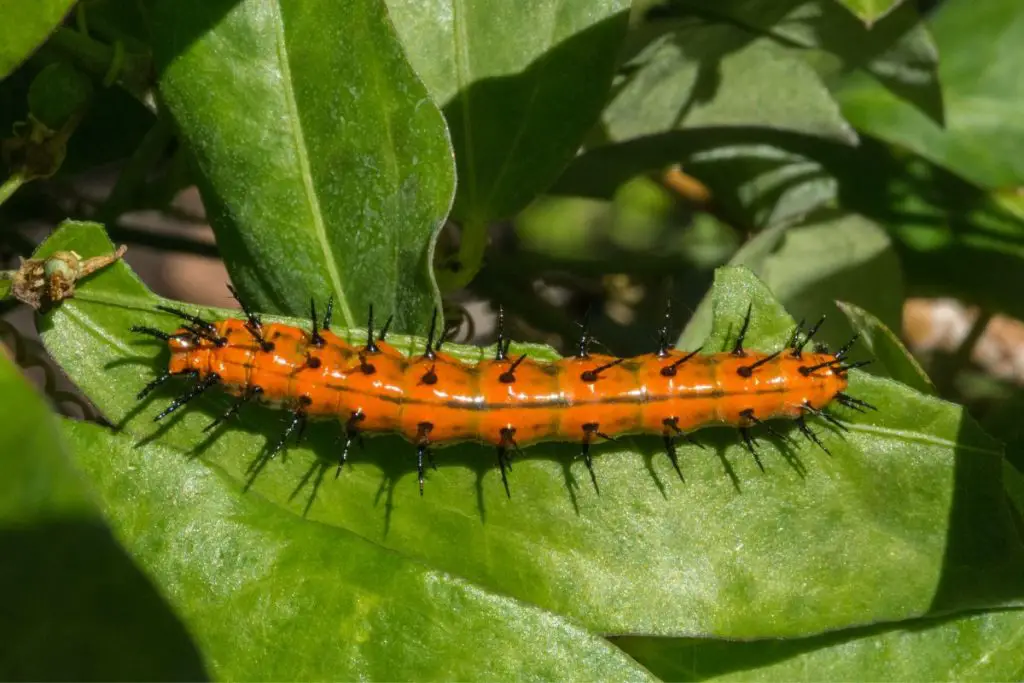
Because gulf fritillary caterpillars consume large amounts of passionflower leaves they are considered poisonous and toxic to predators of eaten! However, they are non-stinging if touched.
Symptoms
- Very Poisonous If Eaten
- Non-Stinging If Touched
Habitat
- Moderately Sunny Areas, And Grasslands
- Found On Passion Vine Plants
6. Oleander Caterpillar
The Oleander Caterpillar, also known as the “Syntomeida epilais” is an incredibly beautiful caterpillar with its bright vibrant colors of orange and black. However, this species bears a striking resemblance to the gulf fritillary caterpillar and is often mistaken for one another.
The stark contrast between the orange and black makes them immediately recognizable, but upon closer inspection one will see that the black spikes of the oleander caterpillar are ever so slightly larger than those of its relative.
Native to the Southern regions of Florida, these small caterpillars frequently dine on oleander plants “Nerium oleander” for their lush foliage and abundant flowers.
However, this plant is extremely toxic, just touching the plant or sap can induce toxic effects.
But, caterpillars, like the oleander, are immune to this plant’s poison as they consume the “glycosides” from the leaves. As a result, they store the toxins in their bodies making them very poisonous.
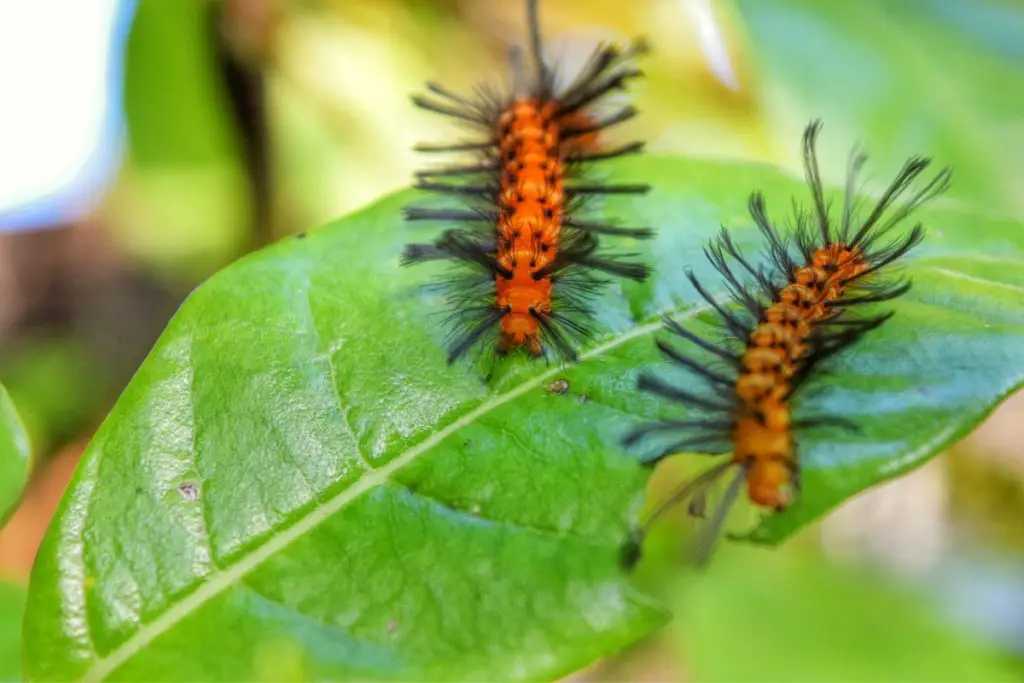
Therefore, if a predator were to attempt to eat them, the caterpillar would be so toxic it would result in a very nasty reaction that could be fatal to the animal.
Most caterpillars that have hairs do have a reputation for stinging you. These types of hairs are called “urticating hairs” the good news is the hairs on oleander caterpillars will not sting nor will they bite you! But, can cause an itchy skin rash.
Symptoms
- Itchy Skin Rash If Touched
- Very Poisonous If Eaten
Habitat
- Native To The Southern Regions Of Florida
- Found On Oleander Plant Leaves
7. Mourning Cloak Caterpillar
The Mourning Cloak Caterpillar is a unique species of butterfly-like insect, native to North America and parts of Europe. Its defining feature is its “urticating hairs” which are primarily orange with a black body and orange spots along the top of the caterpillar.
This fur serves two purposes, firstly it provides camouflage against predators, and secondly, the toxins that are stored within the caterpillar’s body make them very unpleasant tasting to most predators.
If you have the misfortune of coming into contact with the Mourning Cloak Caterpillar, those hairs can attach to your skin, releasing a toxin poison that can potentially cause reactions such as redness, irritation, and swelling.
Even for non-allergic individuals, it is best to avoid touching these caterpillars unless under controlled circumstances like wearing gloves.
This caterpillar is a common sight for those out for a nature walk as they feed in large groups on trees including willow, hackberry, aspen, cottonwood, poplar, elm, rose, birch, Hawthorne, and mulberry.
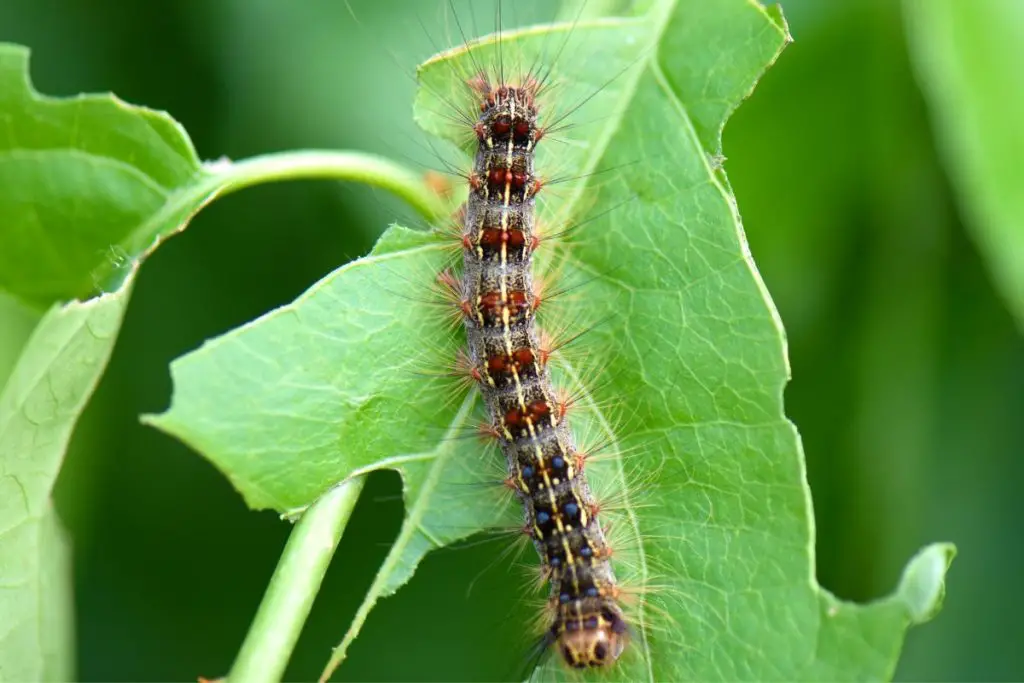
If you do come across one of these caterpillars, it is best to observe them and not attempt to touch or pick them up. Again you can use gloves if you’re trying to remove them from your garden.
Symptoms
- Redness, Irritation, And Swelling
- Blisters On The Skin
Habitat
- Native To North America And Parts Of Europe
- Found On A Large Number Of Trees
8. Pipevine Swallowtail Caterpillar
The Pipevine Swallowtail Caterpillar never fails to attract the eye of any passing admirer! With its unique feature of a black horn body with orange spots, it’s a colorful caterpillar that resembles its adult form.
These caterpillars are found mainly in gardens and fields where they feed on pipevine plants “Aristolochia” for their lush foliage.
These plants contain a powerful toxin called aristolochic acid which can be toxic if eaten!
But luckily the swallowtail caterpillar is immune to this poison and can consume the plant freely without any adverse effects!
As a result, the toxins from these plants stay in the caterpillar’s body, making them highly toxic and poisonous if touched!
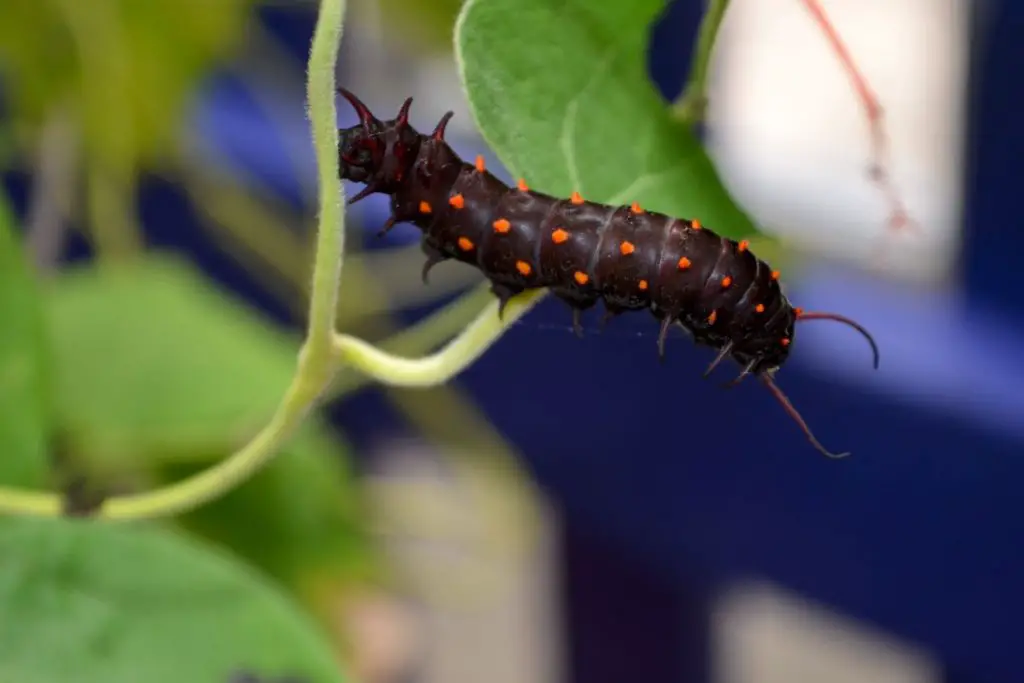
In fact, the Poison is contained in its spiny follicles which can cause an allergic reaction if people come into contact with it. Thankfully, there are easy ways to stay avoid this! Like with all poisonous caterpillars, wearing gloves would be your best bet.
Symptoms
- Can Cause A Skin Rash If Touched
- Very Poisonous If Eaten
Habitat
- Native To Central Florida, Arizona, Mexico
- Found Underneath Pipevine Plants
Are All Black And Orange Caterpillars Poisonous To Handle?
Many people are under the impression that all black and orange caterpillars are poisonous and dangerous to handle. However, that is not the case – while some of them may be poisonous, there is actually a wide variety of black and orange caterpillars which are perfectly safe to touch.
With that said, It’s important to remember that not all black and orange caterpillars should be handled – it’s better to err on the side of caution and avoid contact for safety purposes – however doing so doesn’t mean all of them will cause you harm.
Related Articles:
What To Do If You Come Into Contact With One?
If you come into contact with an orange and black caterpillar, it is important to remain calm and remember that these creatures are usually not dangerous. However, there are some steps you can take just to be on the safe side:
- Wash your hands immediately.
- If irritation persists, seek medical attention.
- Determine if the caterpillar is poisonous or not.
If you find out that the caterpillar is poisonous and you’re experiencing some of the symptoms, mentioned in this article then it’s very important to seek medical attention as soon as possible.
Are Black And Orange Caterpillars Poisonous To Pets?
Black and orange caterpillars can be very dangerous to pets if ingested. So it’s important to keep a close eye on animals when they are in areas known to have such venomous larvae.
If a pet does manage to eat one of these caterpillars, it can be deadly! If this is the case, it’s highly recommended to consult with your local vet and get help as soon as possible.
Taking preventative steps such as keeping pets leashed and away from plants that may attract these caterpillars are the best way an owner can ensure the safety of their animal companion.
How To Safely Remove A Black And Orange Caterpillar From Your Plants?
Although these caterpillars are somewhat poisonous they can also cause high damage to your plants if left alone leaving no choice but to remove them.
However, the most important thing is to do it safely and without coming into contact with their toxic hairs or skin secretions.
The best way to do this is by wearing protective gloves and using a tool like a pair of tweezers or forceps to gently lift the caterpillar off the plant and dispose of it in a sealed container away from your garden.
Preferably you should take the caterpillar to your local woods or meadow and place them leave so it has a chance to continue its life cycle.
Conclusion
So there are 8 different species of black and orange caterpillar species that are poisonous! Just make sure to proceed with caution if you are going to remove them.
If you’ve found this article to be informative and helpful don’t forget we have a wide range of articles like this regarding the different species of caterpillars or other insects for that matter.
Related Articles:
